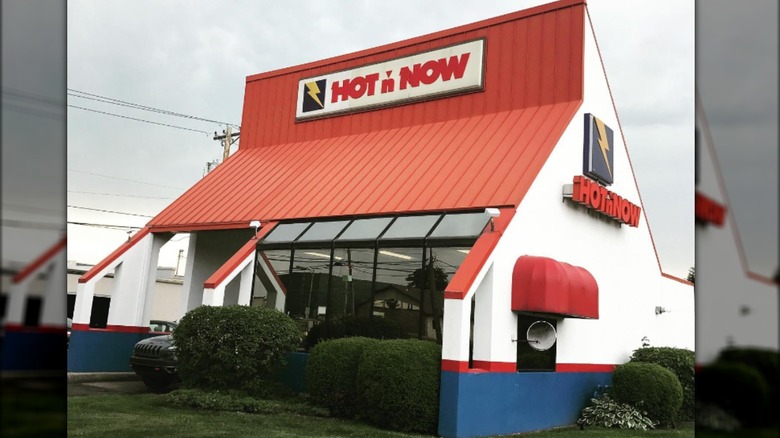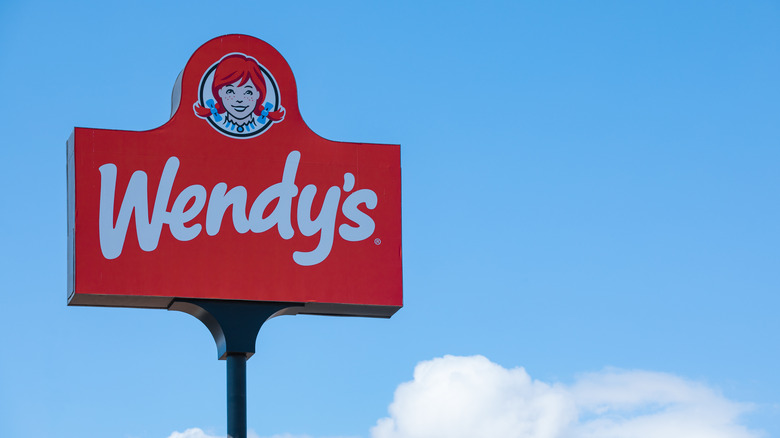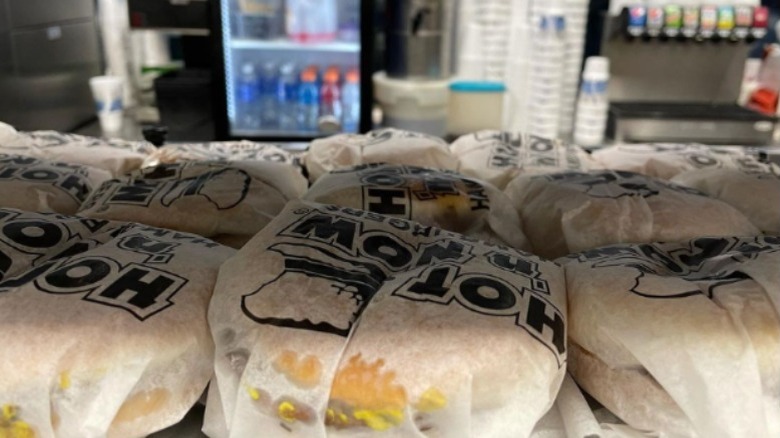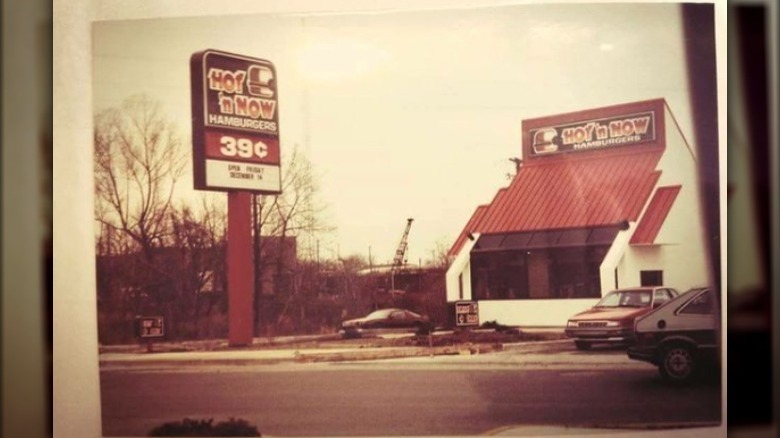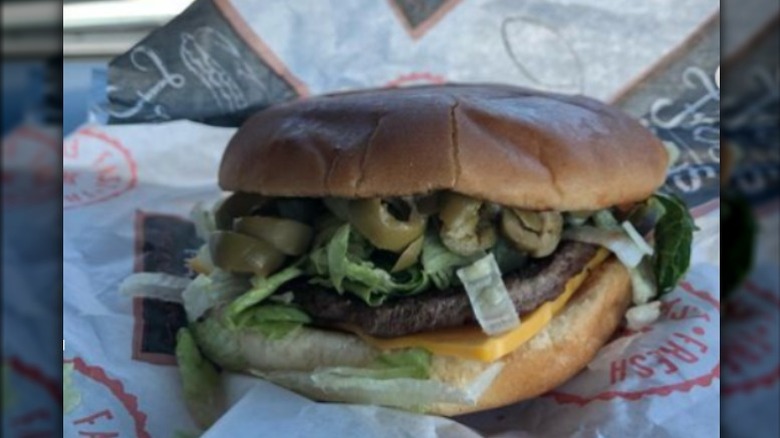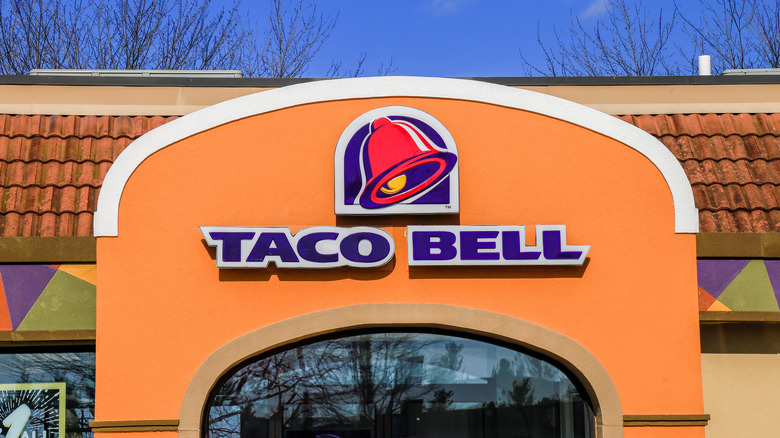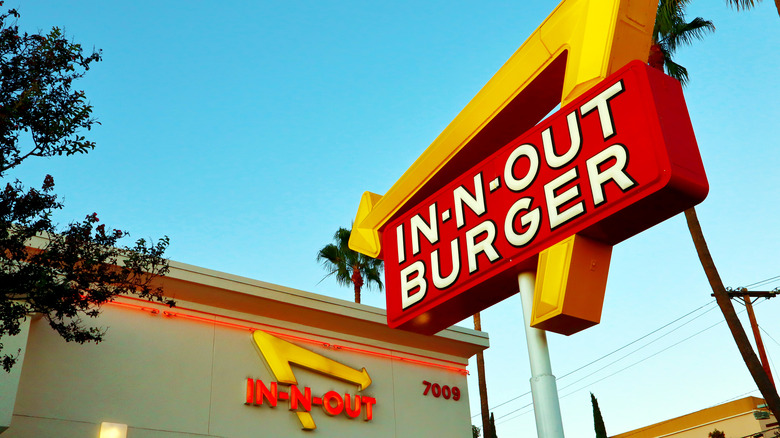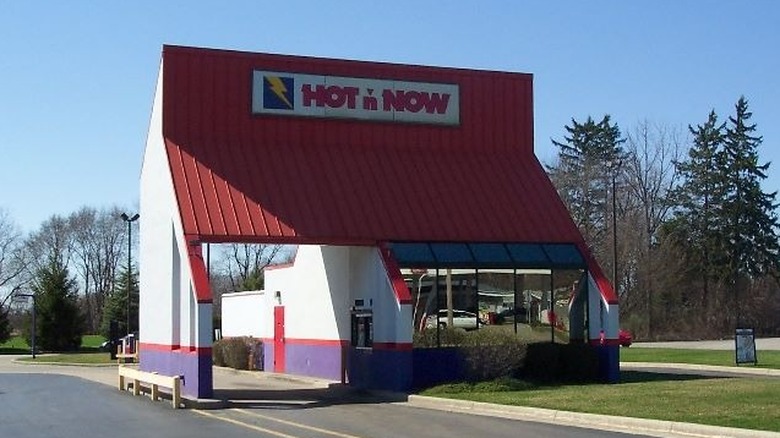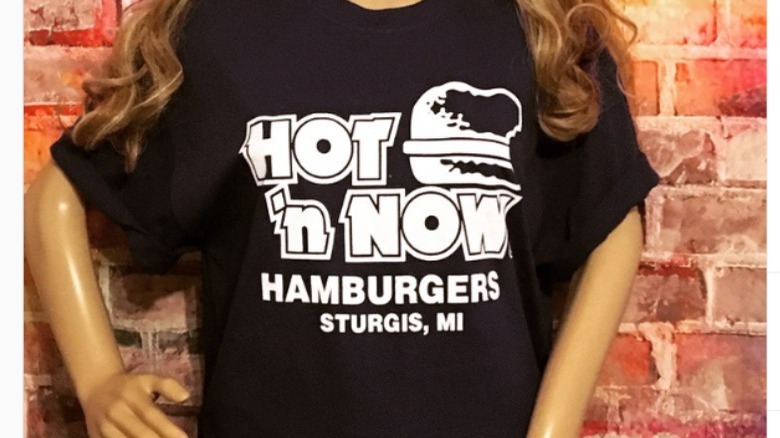The Story Behind The Rise And Fall Of Hot 'N Now
If you ask a former '80s or '90s kid from the Midwest, chances are they remember Hot 'n Now. Cheap burgers, cheap fries, and a drink delivered fresh, hot, and fast! No inside seating and no counter to order from. Just a simple menu and a drive-thru window. Hot 'n Now was the brainchild of experienced franchisee William "Bill" Van Domelen, who wanted to perfect the fast food model with an emphasis on "fast."
The first Hot 'n Now opened in 1984 in Kalamazoo (yes, there really is a Kalamazoo), Michigan. At its height, the fast food chain numbered about 150 locations across 15 states, per WRKR radio station. Now, nearly 40 years later, only one location remains in operation in Sturgis, Michigan, located along the Michigan-Indiana border about 45 miles south of its Kalamazoo origins.
How did this happen? Was it a faulty business model? Did the fast food landscape become too aggressive to compete in? Some blame Taco Bell. Others blame Pepsi. Perhaps it was just fate. To figure out this puzzle and decide for yourself what happened, just keep reading.
Hot 'n Now founder Bill Van Domelen opened the first Wendy's in Michigan
William "Bill" Van Domelen was born during the Great Depression in Grand Rapids, Michigan, according to his obituary from Betzler Life Story Funeral Homes. Some of his first jobs were working as a busboy in downtown Grand Rapids restaurants. His first foray into restaurant franchising was with the now defunct fast food chain Burger Chef. He opened two locations south of Grand Rapids in Kalamazoo, Michigan, followed by a Dunkin' Donuts.
Riding the waves of his success, Van Domelen then opened the very first Wendy's restaurant in the entire state of Michigan, also located in Kalamazoo. Then he opened the second. From there Van Domelen helped build the Wendy's chain throughout the southwest Michigan region.
Learning from his experiences with these various fast food restaurants, Van Domelen believed he could make something better, faster, and less expensive. And he was right! Thus Hot 'n Now was born. Unlike his other fast food restaurants, Hot 'n Now did not have indoor seating and was built around the drive-thru concept, though some locations also had a walk-up window (per The Breakdown with Luke via YouTube).
Hot 'n Now really did live up to its name
While the uniform white buildings with their red roofs and the lightning bolt logo may have been iconic, Hot 'n Now was a no-frills business. Founder Bill Van Domelen was sincere about putting the "fast" in fast food. He insisted his Hot 'n Now customers would get their orders still steaming and in under 30 seconds from ordering, hence the right-to-the-point name of the new venture (per YouTube's The Breakdown with Luke). Some locations even had two drive-thru windows, one on either side of the building, to handle rush hours.
Van Domelen was a big believer in the KISS business model, which stands for keep it simple, stupid. Though, so as not to insult his employees, it was often shortened to just KIS. The menu was limited to burgers, french fries, and soft drinks, which made choosing what to order simpler for the customer. The assembly of these items is quick and easy, making the job easier for employees as well.
Hot 'n Now consistently undersold the competition
At only 39 cents for a hamburger and 49 cents for a cheeseburger, you could buy, as one Redditor put it, "a bonkers amount of burgers for almost nothing." An order of french fries and a drink were also only 39 cents each, the Miami Daily Business Review reported via the law firm Zarco Einhorn Salkowski & Brito. According to Insider, in 1985, the year after Hot 'N Now opened, a hamburger at McDonald's cost 50 cents, and a Burger King burger cost 99 cents. And both chains continued to raise their prices in the ensuing years while Hot 'n Now's remained the same.
Hot 'n Now's specialty burgers like the Bolt Jr. with its lettuce, onion, tomato, pickles, and condiments on a sesame seed bun were a bit more. The Bolt Jr. cost only 69 cents in the mid-1990s (per YouTube). According to the commercials that played at the time, a comparable burger sold by a competing chain restaurant cost 99 cents. Insider agreed, reporting that in 1994, the average fast food hamburger price was 91 cents. A Bolt Jr. combo with burger, fries, and a drink was $1.49. The comparison meal was $1.99.
The olive burger was a menu staple
If you aren't from Michigan, you may be asking yourself, "The what now?" The olive burger was invented in Michigan, as reported by the Lansing State Journal, in the 1920s. It might be as iconic a Michigan food as the Coney Island dog.
For some, the olives are chopped and mixed with mayonnaise and olive brine, making a sauce that is spread on the burger. For others, the olives are sliced and spread on top of the burger patty, similar to how some people place pickles or slices of onion.
The Hot 'n Now olive burger was of the latter variety: a hamburger topped with lettuce, tomato, mayonnaise, and sliced green olives. You can still buy one at the sole remaining Hot 'n Now location in Sturgis. Eric Meier, a radio host for Kalamazoo's WRKR station, said about the unique burger, "I always thought olives were gross as a kid. But you know what? An olive burger was a buck and a quarter, and once I ate one I thought, 'Whoah, that was pretty good!'" (per Lansing State Journal).
Taco Bell acquired Hot 'n Now in 1990 and changed things
Bill Van Domelen's success in founding Hot 'n Now did not go unnoticed. In 1990, PepsiCo purchased the burger chain from Van Domelen and put it under the Taco Bell brand, which it owned at the time (per the Los Angeles Times).
Unsatisfied with the simple menu, Taco Bell decided to expand it and add new items, such as a quarter pound burger, offering customers more options but slowing down the delivery time. It used Hot 'n Now to test new product ideas and began to ignore franchisees. Taco Bell also changed the recipe for the hamburger patties, which did not go over well with all customers, according to former franchisee Richard Loehr, who said the new meat tasted burned (per the Miami Daily Business Review).
Van Domelen himself was not happy about the direction Taco Bell was taking his former business. He told the Los Angeles Times, "They changed the concept. The menu is more complicated and the service is definitely slower. ... The franchisees would call me but I'd have to say I didn't know what was going on. All I knew is that the changes were counterproductive."
Franchisee Richard Loehr sued Taco Bell in 1995
Richard Loehr opened his first Hot 'n Now franchise in 1990 (per the Miami Daily Business Review). He felt reassured by the support that he received from corporate and founder Bill Van Domelen. Then the chain was sold to PepsiCo/Taco Bell.
At first, not much changed. Then, in 1992, Loehr claimed Taco Bell began messing with a good thing, to franchisees' detriment. "Because they didn't know how to run a small system, they drove the business into the ground," he said in a report by the Miami Daily Business Review. "[Taco Bell] tried running the stores without shift managers, which you can't do in this business, and cut out all promotional materials that generate money, and relied only on giveaways."
Nevertheless, Loehr was willing to stick it out for another few years, opening more Hot 'n Now locations. However, customers were confused by all of the changes, and wait time and costs went up. Loehr claimed that this ruined his business, and he sued Hot 'n Now, PepsiCo and Taco Bell in 1995. Attorney Robert Zarco, who represented Loehr, said, "Taco Bell bought the Hot 'n Now system and changed it so much that the system lost its effect on the market, causing my client to go out of business."
By the time Loehr's case went to trial in 1996, Taco Bell had already sold the chain to another company. His case, though, was not successful, per MoreLaw.
Van Domelen took Pepsi's money and became a philanthropist
Bill Van Domelen was a successful businessperson even before selling the Hot 'n Now chain to PepsiCo in 1990. He and his wife, Julia, whom Bill married in 1993, per Van Domelen's obituary, worked together to benefit the communities in which they lived. (The couple had homes in both Michigan and Florida.)
The Bill and Julia Van Domelen Foundation, based in Kalamazoo, Michigan, has been operating as a nonprofit since 1991. According to MLive, it gave $5.5 million in 2009 to building the Kalamazoo nursing home Borgess Gardens. Five years later, the couple received the Borgess Lamplighter Award for their contributions to the medical community. Another local beneficiary was the Ministry with Community, which was also raising money for a new building. In 2019, the foundation gave money to the Catholic Church Extension Society of the United States of America, the Guadalupe Center, the Naples Children and Education Foundation, and two others, per Cause IQ.
As president of the foundation, Julia Van Domelen continues her and her husband's philanthropic work today.
Hot 'n Now is likely the reason In-N-Out now serves Coke products
After PepsiCo, under its Taco Bell brand, acquired Hot 'n Now in 1990, it went ahead with plans to open more Hot 'n Now locations, spreading out across the United States as far west as Oregon and, more importantly, California (per the Milwaukee Record).
Despite owning several fast food brands at the time (Taco Bell, KFC, Pizza Hut, and Hot 'n Now), PepsiCo's main brand was itself, supplying soft drinks to numerous restaurants that it didn't own. That included California's favorite fast food chain In-N-Out. Some claimed that In-N-Out resented PepsiCo bringing Hot 'n Now into its territory, breaking an agreement that the two companies had to not compete in this way (per YouTube's The Breakdown with Luke).
In-N-Out elected to not renew its contract with PepsiCo and switched to serving Coke products instead, which it continues to carry today. It is speculated that in an effort to avoid similar disagreements with other chains in the future, PepsiCo was stymied in its attempts to expand Hot 'n Now, which may have contributed to the chain's downfall.
Proquest bought Hot 'n Now then changed its name to Hot Brands Inc.
No one seemed able to repeat Bill Van Domelen's success. Taco Bell sold the chain in the mid-1990s to a Connecticut company after closing at least 8o Hot 'n Now locations (per Miami Daily Business Review). In the early 2000s, Hot 'n Now was based in Holt, Michigan, and had 44 locations across Michigan, Wisconsin, and Indiana. A little less than half were franchises. According to the Midland Daily News in 2002, the chain was struggling, and restaurants were being closed. Vice President of Operations Paul Warren said, "Sometimes you've got to take a couple steps back to strengthen the ship to move forward."
A year later, Hot 'n Now was sold to Nevada-based Proquest Capital Corporation (per Globe Newswire). The burger chain was described as fast growing, and Proquest had high hopes. Proquest changed its name to Hot Brands Inc. to illustrate this point. Chairman and CEO at the time, William Curtis, said, "Strong brand identity starts with our own name — Hot Brands!"
It isn't clear exactly what happened to Hot Brands Inc. The Lansing State Journal mentioned in passing that in 2004, Hot 'n Now, just a year after being procured by Hot Brands Inc., filed for Chapter 11 bankruptcy protection. Bizapedia now lists Hot Brands Inc. as inactive, and, today, there is only one Hot 'n Now restaurant left.
The last Hot 'n Now is in Sturgis, Michigan
The lone Hot 'n Now in Sturgis, Michigan, sits along the Michigan-Indiana border, making it a convenient destination for fans in southwest Michigan and northern Indiana, including the Chicago metropolitan area. This location earned its last-of-its-kind status when another Hot 'n Now location in Bay City, Michigan, closed after a grease fire badly damaged the building in 2016 (per MLive). After repairs, the site reopened as Burger 81, which retains the distinctive Hot 'n Now architecture and even serves olive burgers.
With a team of 25 employees, the Sturgis location served about 300 customers per day, according to a 2018 article from the Lansing State Journal. Earnings took a hit in the mid-1990s under Taco Bell's leadership, but the crew sticks with founder Van Domelen's simple vision and continues to thrive. Burgers, fries, and soft drinks are $1, and there are other options on the menu, such as chicken and fish.
The owner of the Sturgis Hot 'n Now, Kees Van Zelst, still likes running the drive-thru restaurant, telling the Lansing State Journal at the time, "We'll see how things turn out. Maybe I'll sell it to someone very interested."
Hot 'n Now's owner doesn't actually own the trademark
There's a funny thing about that last Hot 'n Now location. The Lansing State Journal reported that owner Kees Van Zelst doesn't actually own the Hot 'n Now trademark. One of its reporters discovered that the trademark is in fact owned and was renewed in 2016 by BTND LLC, a company based in West Fargo, North Dakota.
It doesn't run any Hot 'n Now locations, but BTND LLC does operate a fast food chain of about 10 locations called Burger Time, which first launched in 1972. There are three locations in Minnesota, four in North Dakota, and two in South Dakota. The menu is simple and similar to what you find at the Sturgis Hot 'n Now. Alas, however, there is no olive burger.
None of the currently operating Burger Time buildings look like they were former Hot 'n Nows, and the burger and shake logo doesn't remotely resemble a lighting bolt. So we really aren't sure what BTND LLC is doing with the trademark. And neither does Van Zelst, who said, "They don't bother me, and I don't bother them. It's a two-way street."
